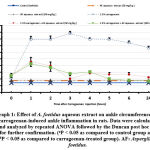Walaa K. Al-Maghraby1* , Nada M. Doleib1,2
, Nada M. Doleib1,2 and Hend M. Taha1,3
and Hend M. Taha1,3
1Department of Biology, College of Science and Arts at Khulis, University of Jeddah, Jeddah, Saudi Arabia
2Department of Microbiology, Faculty of Applied and Industrial Science, University of Bahri, Khartoum, Sudan
3Zoology Department, Faculty of Science, Suez Canal University, Ismailia, Egypt
Corresponding Author E-mail: walaakh1432@gmail.com
DOI : https://dx.doi.org/10.13005/bpj/2394
Abstract
Medicinal plants represent an important source of novel pharmaceutical products. More than 25% of current medicines are derived from natural substances, and another 25% are structural changes of major substances from natural sources. It is estimated that only 15% of higher plants have been investigated for potentially useful biological activity. In recent years, the search for new therapies has been directed to endophytes, as these microorganisms have produced several new and interesting bioactive metabolites for a variety of uses. Endophytes are organisms that colonize the internal tissues of plants without apparently damaging the host. Endogenous mushrooms from medicinal plants are potential antioxidant resources. The overall goals of the work proposed in this application evaluating antimicrobial and anti-inflammatory agents from endophytes isolated from some wild plants in Saudi Arabia.
Keywords
Antimicrobial Activity; Aspergillus Sp; Endophytes; Leptadenia Pyrotechnica
Download this article as:| Copy the following to cite this article: Al-Maghraby W. K, Doleib N. M, Taha H. M. Molecular Profiling and Potential Bioactive Characteristics of Endophytic Fungi Isolated from Leptadenia Pyrotechnica. Biomed Pharmacol J 2022;15(1). |
| Copy the following to cite this URL: Al-Maghraby W. K, Doleib N. M, Taha H. M. Molecular Profiling and Potential Bioactive Characteristics of Endophytic Fungi Isolated from Leptadenia Pyrotechnica. Biomed Pharmacol J 2022;15(1). Available from: https://bit.ly/3w8yWFl |
Introduction
Due to the increasing global concern over the failure of antibiotics to effectively fight against super-resistant bacteria, the development of new antimicrobial agents is becoming a must In the last few decades 5. From 1981 to 2006, nearly 70% of new drugs and chemical active ingredients had natural sources12. Microbes have been a source of new chemo-type and pharmacophores for thousands of years. In the past, they have been able to produce novel compounds 19,1 . Endophytes are microorganisms found in the biological tissues of various plants that have no obvious symptoms of the disease and are interrelated.2,21 . Some endophytes can produce bioactive metabolites that have important uses in the health industry. These compounds are known to be an effective source of bioactive agents.20,17. Also Gouda et al.7 reported that Endophytes are an internal symbiotic group of microorganisms that colonize plants and microorganisms and are easily isolated from the growth medium of microorganisms and plants. They act as reservoirs of novel compounds that can be used for the treatment of various diseases and conditions. Host endophytic microbes can also serve as sources of drug discovery. The Leptadenia pyrotechnica is known to cure various diseases. Has antioxidant properties and various healing powers9 . The present study was carried out to investigate the anti-inflammatory and antimicrobial properties of the Leptadenia pyrotechnica.
Materials and Methods
Must be sterilized before removing tissue. This procedure is carried out by removing the surface microorganisms using Petriniet al 15.
Isolation of Fungal Endophytes form plant samples
Surface sterilized leaf pieces were then imprinted on the PDA plates to check the efficacy of the procedure. All dissected tissue samples were then placed in Petri dishes containing PDA medium containing chloramphenicol (0.05 gm.l-1 ).
Manipulated PDA plates without tissue segments are also run in parallel with the test to check for infection. All Petri dishes are sealed with sterile parafilm to protect them from infection during repeated handling while being analyzed for ascending endophytes. plates were incubated in an incubator at 28 ° C for 7 days. Fungal tissue was found daily for 7 days. Fungi grown from tissue fragments were subculture in PDA Petri dishes. The isolates obtained were purified by transferring each isolate to a fresh plate several times until pure culture obtained 6.
Identification of endophytic fungi
Microscopic and Morphological Identification
The remoted endophytic fungi had been visually determined concerning macroscopic (morphology, size, mycelial and agar color) and microscopic (presence of spores or different reproductive structures) traits with the help of standard taxonomic manuals 3,24 .
Molecular Characterization of Endophytic Fungi
Fungal DNA extraction using Qiagene kit
Endophyte isolates have undergone molecular characterization based primarily on ITS sequencing. DNA isolation was performed by the CTAB NaCl technique and is shown in Figure 1 by agarose gel electrophoresis.
Agarose gel electrophoresis
The favored quantity of agarose (0.8-2%) become brought to one hundred mL (1 X) of electrophoresis buffer (10X TBE, Tris-Borate EDTA, tris-base 108g/l; boric acid, 55g/l; 40ml of 0.5M EDTA (pH8)). The gel become boiled and ethidium bromide solution (0.5ug/ml) become brought at 55°C, then poured into sealed gel tray and the ideal comb become inserted.
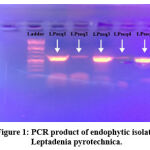 |
Figure 1: PCR product of endophytic isolate Leptadenia pyrotechnica. |
Polymerase chain reaction (PCR)
Taq PCR Master mix (purchased from Qiagene) become used to extend or synthesize DNA (genomic or plasmid) fragments the use of a thermal cycler device (gradient Robocycler ninety six Stratagene, USA) on the Regional Center for Mycology and Biotechnology with the aid of using combining 50ml of the Master Mix (2.5U Taq DNA polymerase, 200mM of every dNTP, 1x Qiagene PCR buffer), 50-a hundred pmole of every primers, 20-200ng DNA as a template in a hundredml of general response volume. The aggregate is then immediately placed in the thermal cycler to initiate the appropriate PCR software with the widely used denaturation cycle (five min at 94°C), 30 cycles of annealing/extension reactions (20 sec at 94°C, 30 sec at an most useful annealing temperature for every amplified fragment and 60 sec at 72°C) and cycle of very last extension step (five min at 72°C) With immersion at 4 ° C.
Purification of DNA fragments from the gel
The DNA fragments involved (PCR products and linear plasmids) were purified by agarose gel electrophoresis using correct gel recognition stained with ethidium bromide. The vicinity of the involved band became decided through the use of the best ladder as a DNA marker at the UV trans- illuminator. The gel slice containing the favored band became then eliminated from the gel and transferred to a dialysis bag, which became packed with the eluting solution (1x TBE, 0.five% SDS), after which positioned once more in an electrophoretic marine. Using the identical electric powered present day the band will circulate from the gel slice to the encompassing buffer, then the buffer became transferred to a 1.five mL tube and an identical quantity of PCI became brought to extract the DNA. After five min of centrifugation the higher layer became eliminated in a brand new 1.five mL tube; 2 mL of absolute ethanol became brought to precipitate the DNA, which became re-suspended in the best quantity of TE buffer11.
DNA sequencing
Sequencing of plasmid and amplified PCR fragments became achieved with the aid of using Cy5/Cy5.five Dye Primer Sequencing package from Visible Genetics Inc. For use with OpenGene’s computerized DNA sequencing gadgets 16,23 .
Primer sequences used for the identity of 18s in the current study
ITS1( 5′- TCC GTA GGT GAA CCT GCG G-‘3)
ITS4 (5’- TCC TCC GCT TAT TGA TAT GC-‘3).
Phylogenetic Analysis of Tested Isolates
The nearly entire 18S rRNA gene collection of lines LPseq1, LPseq2, LPseq3, LPseq4 and LPseq5 become received and as compared with kind lines to be had on the National Center for Biotechnology Information .
Secondary metabolite extraction
Increased mass of natural fungi isolates was cultured in Erlenmeyer flasks (250 ml each) containing 100 ml of potato-dextrose broth medium for liquid culture. The flask become incubated at 28 °C for two week with periodical shaking at a hundred and fifty rpm. After the incubation period, the fermentation broth of the fungus become homogenized with the aid of using including 10 % methanol to it. Metabolites become extracted with the aid of using solvent extraction system the usage of ethyl acetate as natural solvents and distilled water to achieve aqueous solution. To the filtrate same quantity of solvents had been added, blended nicely for 10 min and stored for five min until the 2 clean immiscible layers formed. The higher layer of solvent containing the extracted compounds become separated the usage of keeping apart funnel. Solvent become evaporated and the consequent compound become dried in rotator vacuum evaporator to yield the crude metabolite 4 . The crude extract become then dissolved in Dimethyl sulphoxide at 1 mg/mL of attention and stored at 4 °C
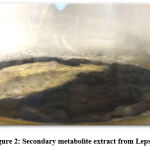 |
Figure 2: Secondary metabolite extract from Lepseq5. |
In vitro Antimicrobial activity of fungal secondary metabolite extract
The antimicrobial pastime of aqueous and natural extracts organized shape Leptadenia pyrotechnica endophytic isolates became decided with the aid of using agar nicely diffusion assay. A overall of 6 reference pathogenic microbial traces have been used withinside the study: Staphylococcus aureus (RCMB010010), Bacillus subtilis RCMB 015 (1) NRRL B-543, Escherichia coli (RCMB 010052) ATCC 25955, Klebsiella pneumonia RCMB 003 (1) ATCC 13883, Candida albicans RCMB 005003 (1) ATCC 10231 and Aspergillus fumigatus (RCMB 002008). The take a look at organisms have been inoculated in Nutrient broth and incubated in a single day at 37°C to regulate the turbidity to 0.5 McFarland standards. Inoculum of pathogenic micro organism and fungi containing 1.5 × 108 cfu/ml have been unfold on Muller Hinton agar (MHA) plates. Extracts of 10 mg/ml attention have been organized in Dimethyl Sulfoxide (DMSO). Subsequently, wells of 6 mm diameter have been bore into the agar medium and packed with a hundred μl of examined extract and allowed to diffuse at room temperature for 30 min The plates were incubated in an upright position at 37 ° C. for 48 hours. If the controls are inadequate, Use wells of DMSO (1%) in the same proportions as the epidemic antibiotic gentamicin (12 µg / ml for bacteria) and ketoconazole (25 µg / ml for fungi). ml) was used for fine adjustment). After incubation, the diameter of the beautiful Zune was measured in mm. In contrast to all other organisms, each extract was tested 3 times. The data are expressed as mean ± trend deviation.
Experimental animals
All the experimental strategies and protocols used on this take a look at had been reviewed via way of means of the Institutional Ethical Committee of European Community guidelines; EEC Directive 86/609/EEC, of the twenty fourth November 1986 .
Acute toxicity and determination of fungi extract median lethal dose (LD50)
LD50 of the A. foetidus aqueous extract became decided in keeping with the technique of Lorke (1983).
Determination of in vivo anti-inflammatory effect of the extracted
Carrageenan-brought on rat paw oedema is a broadly used check to decide anti-inflammatory interest and constitutes a easy and recurring animal version for assessment of ache on the web website online of infection with none harm or harm to the infected paw 22,8, 10,13,14,18.
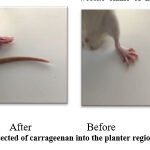 |
Figure 3: Injected of carrageenan into the planter region of rat paw. |
Adjustments within the extension of the foot were measured at an abnormal time after carrageenan injection. The percentage of edema suppression is calculated using the following
formula:
Here, Tt is the paw thickness of the rat to which the test extract was administered at the corresponding time, and To is the paw thickness of the rat of the control group at the same time.
Statistical analyses
The statistical evaluation changed into finished the usage of evaluation of variance (ANOVA) to evaluate extract results to their respective controls. We additionally finished Post-hoc checks the usage of Bonferroni more than one variety take a look at for decide supply of differences. The importance stage used changed into 0.05 (α).
Results
Morphological and Microscopic Identification
Lepseq1 (Aspergillus flavus) It produces yellow-green, white, delicate velvety colonies that are the pigments of conidia spores. The mycelium is clean, leading to inexperienced olive modifications and colorless sclerotia.
Lepseq2 (Aspergillus fumigatus) produces yellow-brown and inexperienced coloured colonies. The colonies have a clean floor and the floor of the conidia is both clean or spinose.
Lepseq3(Aspergillus parvathecius) Colonies reasonably deep, sulcate; margins barely irregular; mycelium white; texture floccose; sporulation sparse; soluble pigments absent; exudates absent.
Lepseq4 (Aspergillus terreus) Showed a colony that looked like a rapidly developing powdered colony with a functional brown or cinnamon brown tint on the bottom and a yellow to beige brown tint on the back.
Lepseq5 (Aspergillus foetidus) The colonies begin with a white to yellowish felt mycelial mat, quickly turn black like conida, and swell the pigment aspergillin at some point during the maturation process. The back remains white.
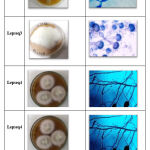 |
Table 1: Morphological and microscopic observation of endophytes isolated from Leptadenia pyrotechnica. |
Molecular identification
Endophytic fungi have been recognized .The DNA sequences have been decided the usage of BLAST and evaluating statistics to the NCBI GenBank database. The fungus have been recognized the usage of trendy Polymerase Chain Reaction (PCR) evaluation through ITS-rDNA amplification technique with identification and feature ranging from (99.25% to 100 %). The nucleotide sequences of the ITS1 areas of the 5 investigated isolates have been decided, and the lengths, GC contents, and GenBank accession numbers are proven in Table 3. ITS1 sequencing found out huge variabilities among the investigated isolates. The length of ITS1 in the Lepseq1 isolate changed to 513 base pairs (bp), but now it is 404 bp in the Lepseq2 isolate, 540 bp in the Lepseq3 isolate, 404 bp in the Lepseq4 isolate, and 413 bp in the Lepseq5 isolate. rice field. The GC content ranged from 57.1 to 59.8.
Molecular phylogenetic identification of endophytic fungi
Aspergillus flavus Sequence evaluation of the 18S rRNA gene confirmed that pressure Aspergillus flavus Bankit Submission number: 2387747 changed into related to the genus Aspergillus and maximum intently associated with XM_002380164.1Aspergillus flavus (98.83 %). Phylogenetic evaluation primarily based totally on 18S rRNA gene sequences indicated that the pressure shaped a cluster with CP035525.1 Aspergillus sojae (94.93% ), XM_032051468.1 Aspergillus pseudotamarii (92.40%)
Aspergillus fumigatus: Sequence evaluation of the 18S rRNA gene confirmed that pressure Aspergillus fumigatus MT711302.1 changed into related to the genus Aspergillus and maximum intently associated with MN871765.1 Aspergillus fumigatus (99.51%). Phylogenetic evaluation primarily based totally on 18S rRNA gene sequences indicated that the pressure shaped a cluster with MH378448.1 Aspergillus (99%), Aspergillus KP122751.1 Aspergillus fumigatus (99.1%).
Aspergillus parvathecius Sequence evaluation of the 18S rRNA gene confirmed that pressure Aspergillus parvathecius had been related to the genus Aspergillus and maximum carefully associated with Aspergillus parvathecius MK961271.1 (99.25%). Phylogenetic evaluation primarily based totally on 18S rRNA gene sequences indicated that the pressure shaped a cluster with Aspergillus parvathecius ITA9F5 . Aspergillus terreus Sequence evaluation of the 18S rRNA gene confirmed that pressure Aspergillus terreus had been related to the genus Aspergillus and maximum carefully associated with Aspergillus terreus MN871763.1 (99.25%). Phylogenetic evaluation primarily based totally on 18S rRNA gene sequences indicated that the pressure shaped a cluster with MG811572.1 Aspergillus terreus .
Aspergillus foetidus Sequence evaluation of the 18S rRNA gene confirmed that stress Aspergillus foetidus have been related to the genus Aspergillus and maximum intently associated with Aspergillus foetidus KP278200.1 (100%). Phylogenetic evaluation primarily based totally on 18S rRNA gene sequences indicated that the stress fashioned a cluster with Aspergillus welwitschiae MN871761 .
Screening for anti-microbial activity
Secondary metabolites of various remoted endophytes had been examined for antimicrobial sports in opposition to human pathogenic microbes; Gram-poor bacteria; Escherichia coli ATCC 25955 and Klebsiella pneumonia ATCC 13883, Gram-high-quality bacteria; Bacillus subtilis NRRL B-543, Staphylococcus aureus ATCC 25923, unicellular fungi; Candida albicans ATCC 10231 and filamentous fungi; Aspergillus fumigatus ATCC 1022, become decided through agar properly diffusion assay. The antibacterial impact of aqueous and ethyl acetate extracts of remoted endophytes become quantified through region of inhibition .The extracts of examined endophytes at 100µg/mL validated various levels of antimicrobial pastime in opposition to the human pathogenic microbes. One-manner evaluation of variance become finished to decide whether or not region of inhibition approach of various examined extracts had been substantially unique from every different in opposition to human pathogenic microbes. The evaluation indicated that there has been huge variations recorded in region of inhibition among the unique examined isolates extracts (Lepseq1, Lepseq2, Lepseq3, Lepseq3 and Lepseq5, which had been recognized as Aspergillus flavus, Aspergillus fumigatus, Aspergillus parvathecius, Aspergillus terreus and Aspergillus foetidus;
Evaluation of antibiotics activity of aqueous and ethyl acetate extracts endophytic isolates Against Candida albicans
Only extract of Lepseq5 had inhibition area identical to (13.00 mm), but the different extracts did now no longer show off any anti-microbial pastime towards Candida albicans. calcifying Post hoc comparisons the use of the Bonferroni take a look at indicated that the imply rating distinction among superb manage and every of examined extract. Respectively).
Evaluation of antibiotics activity of aqueous and ethyl acetate extracts endophytic isolates Against Aspergillus fumigatus
Aqueous extract of Lepseq2 had inhibition region same to (12.20 mm), aqueous extract of Lepseq5 (45.eighty mm) and ethyl acetate extract of Lepseq5 (35.07mm). which displaying an accelerated full-size distinction while as compared with high-quality manipulate (Gentamycin) (17.eleven mm). calcifying Post hoc comparisons the use of the Bonferroni check indicated that the suggest rating distinction among high-quality manipulate and every of examined extract.
Evaluation of antibiotics activity of aqueous and ethyl acetate extracts endophytic isolates Against Escherichia coli
Aqueous extract of Lepseq2 had the very best inhibition area identical to (30.eighty three mm), ethyl acetate extract of Lepseq5 (28.fifty three mm) and aqueous extract of Lepseq5 (24.ninety four mm). which displaying nonsignificant distinction whilst in comparison with fantastic manage (Gentamycin) (30.seventy seven mm). calcifying Post hoc comparisons the use of the Bonferroni take a look at indicated that the imply rating distinction among fantastic manage and every of examined extract.
Evaluation of antibiotics activity of aqueous and ethyl acetate extracts endophytic isolates Against Klebsiella pneumonia
Aqueous extract of Lepseq5 had the best inhibition region identical to (29.54 mm) which displaying vast boom in comparison with advantageous manipulate; observed with the aid of using ethyl acetate extract of Lepseq5 (24.17 mm) then aqueous extract of Lepseq2 (22.63 mm) . No big difference compared to lucrative operation (Gentamycin) (20.37 mm). calcifying Post hoc comparisons the usage of the Bonferroni take a look at indicated that the suggest rating distinction among advantageous manipulate and every of examined extract.
Evaluation of antibiotics activity of aqueous and ethyl acetate extracts endophytic isolates Against Bacillus subtilis
Ethyl aqueous of Lepseq5 (28.00 mm) then acetate extract which displaying similar values while in comparison with tremendous manipulate; accompanied with the aid of using aqueous extract of Lepseq1 had inhibition area identical to (19.63 mm) then ethyl acetate extract of Lepseq5 (15.33mm) . And tremendous operation (Gentamycin) identical to (26.57mm). calcifying Post hoc comparisons the usage of the Bonferroni take a look at indicated that the imply rating distinction among tremendous manipulate and every of examined extract.
Evaluation of antibiotics activity of aqueous and ethyl acetate extracts endophytic isolates Against Staphylococcus aureus
Aqueous extract of Lepseq5 had the best inhibition sector same to (29.54 mm) which displaying widespread boom in comparison with high quality control; observed via way of means of ethyl acetate extract of Lepseq5 (24.17 mm) then aqueous extract of Lepseq2 (22.63 mm). Which displaying nonsignificant distinction while as in comparison with high quality control (Gentamycin) (20.37 mm).
calcifying Post hoc comparisons using the Bonferroni test indicated that the mean score difference between positive control and each of tested extract.
Table 2: Zone of inhibition (mm) of aqueous and ethyl-acetate extracts of endophytes isolated from Leptadenia pyrotechnica against human pathogens using agar well diffusion assay.
| Antimicrobial activity against pathogens (inhibition zone in mm) | |||||||
| Treatments
(100 µg/ml) |
extracts | Fungi (Yeast) | Gram-positive | Gram-negative | |||
| Candida albicans | Aspergillus fumigatus | Staphylococcus aureus | Bacillus subtilis | Escherichia coli | Klebsiella pneumonia | ||
| Positive control | 20.03a
± 0.96 |
17.11 a
± 0.95 |
24.90 a
± 0.50 |
26.57 a
± 1.01 |
30.77 a
± 0.76 |
20.37 a
± 1.07 |
|
| Negative control | NI | NI | NI | NI | NI | NI | |
| Lepseq1 | aqueous | NI | NI | 18.77 b
± 0.19 |
19.63 b
± 0.22 |
14.73 c
± 0.56 |
15.43 b
± 0.27 |
| Ethyl-acetate | NI | NI | 20.70 b
± 0.38 |
18.43 b
± 0.64 |
17.27 b
± 0.26 |
8.23 c
± 0.28 |
|
| Lepseq2 | aqueous | NI | NI | 9.23 c
± 0.92 |
10.03
± 1.30 |
30.83 a
± 2.52 |
8.03 c
± 0.110 |
| Ethyl-acetate | NI | 12.20 b
± 0.58 |
9.03 c
± 0.41 |
NI | 15.23 c
± 0.54 |
NI | |
| Lepseq 3 | aqueous | NI | NI | 16.63 b
± 0.24 |
14.43
± 0.30 |
14.40 c
± 0.62 |
22.63 a
± 0.26 |
| Ethyl-acetate | NI | NI | 23.17 a
± 0.40 |
17.13 b
± 0.40 |
20.47 b
± 0.69 |
15.57 b
± 0.55 |
|
| Lepseq 4 | aqueous | NI | NI | 17.37 b
± 0.48 |
18.27 b
± 0.45 |
15.20 c
± 0.38 |
12.13 b
± 0.40 |
| Ethyl-acetate | NI | NI | 18.73 b
± 0.20 |
16.57 b
± 0.22 |
NI | 17.30 b
± 0.17 |
|
| Lepseq 5 | aqueous | 13.00 b
± 0.79 |
45.80 c↑
± 1.87 |
25.00 a↑
± 2.46 |
28.00 a↑
± 0.67 |
28.53 a↑
± 1.09 |
29.54 d↑
± 2.15 |
| Ethyl-acetate | NI | 35.07 c↑
± 2.90 |
13.03 b
± 1.15 |
15.33 b
± 0.66 |
24.94 a
± 1.16 |
24.17 d↑
± 1.22 |
|
values are mean ± SD, (NI) denotes no inhibition. Positive control for fungi: Ketoconazole (25 µg/ml) ; positive control for bacteria: Gentamycin (12 mg/ml). Negative control: DMSO (1%). For each column: same letter displayed difference between the means is not statistically significant. . However different letters, means statistically significant difference (p<0.05) Between different treatments.
In end the prevailing consequences concluded that; all endophytic extracts both aqueous and ethyl acetate exhibited no inhibition for Candida albicans and Aspergillus fumigatus also used for stress aqueous extract Aspergillus foetidus which displayed moderate inhibition pastime in opposition to Candida albicans (13.00 mm). However; aqueous and ethyl acetate extracts of Aspergillus foetidus exhibited robust inhibition pastime for pathogenic Aspergillus fumigatus (45.eighty and 35.07 mm, respectively).Aqueous and ethyl acetate Aspergillus foetidus extracts confirmed antibacterial pastime in opposition to pathogenic gram terrible and gram high-quality micro organism with different strength . The inhibition area diameter (IZD) starting from 25.00 to 29.54 mm for aqueous and from 13.03 to 24.94 mm for ethyl acetate extract. The lowest price of IZD have been determined with the aid of using aqueous extract of Aspergillus fumigatus Against Klebsiella pneumonia (8.03 mm).
Anti-Inflammatory Activity of extract in carrageenan -injected Rats
Dose-dependent inhibition of carrageenan caused 24-hour foot edema in rats, which was detected after intraperitoneal treatment of an aqueous A. foetidus extract. (low dose ;50 and excessive dose; a hundred mg/kg). Percent of inhibition rate to 16.69%, 20.05%, 29.30%, 24.67%, 26.56%, 24.66% and 23.76% discovered after 1, 2, 3,4, 5, 6 and 24 hours , respectively after remedy with low dose, while Overdose (a hundred mg/kg) confirmed inhibition of 18.42%, 21.30%, 32.80%, 25.56%, 29.75%, 29.19%, 26.seventy nine after 1, 2, 3,4, 5, 6 and 24 hours , respectively.
Conclusion
By comparing and analyzing rDNA-ITS sequences, five fungi were isolated and identified at the species level. Partial sequence was found to be more closely associated with strains with similarities ranging from 99.25% to 100, according to the data collected. The results were consistent with the results of various studies identifying the same genus isolated from many medicinal plants. Medicinal plants are known to contain endophytes, which are thought to be related to the manufacture of pharmaceuticals25. The antibacterial activity of endophytes isolated from the leaves of Leptadenia pyrotechnica was investigated. Of all the endophytes tested, the aqueous extract of Aspergillus foetidus showed significant antibacterial activity against all test pathogens. An acute (carrageenan-induced foot edema) inflammation model in rats was used to study the anti-inflammatory activity of an aqueous A. foetidus extract. Leptadenia pyrtechnica leaves endophyte is promising not only as an antibacterial agent against human pathogens, but also as an anti-inflammatory agent. May be considered a sustainable resource for new biologically active secondary metabolites that can be developed as new drugs.
Acknowledgments
We acknowledged all individuals included in our research.
Competing interests
No conflict of interest.
Reference
- Aly, A.H., Debbab,A., Kjer, J., and Proksch, P., 2010, Fungal endophytes from higher plants: a prolific source of phytochemicals and other bioactive natural products. Fungal Diversity, 41,:1-16.
CrossRef - Araújo, W. L., Marcon, J., Maccheroni, W., van Elsas, J. D., van Vuurde, J. W., & Azevedo, J. L. (2002). Diversity of endophytic bacterial populations and their interaction with Xylella fastidiosa in citrus plants. Applied and environmental microbiology, 68(10), 4906-4914.
CrossRef - Barnett, H.L. and Hunter, B.B. (1998) Illustrated Genera of Imperfect Fungi. 4th Edition, APS Press, St. Paul, 218 p.
- Bhardwaj A, Sharma D, Jodan N, Agrawal PK. Antimicrobial and phytochemical screening of endophytic fungi isolated from spikes of Pinus rouxburghii. Arch Clin Microbiol. 2015;6(3):1
- Dias, T.B., Yang, Y.J., Ogai, K., Becker, T., and Becker, C.G. (2012) Notch signaling controls generation of motor neurons in the lesioned spinal cord of adult zebrafish. The Journal of neuroscience : the official journal of the Society for Neuroscience. 32(9):3245-3252.
CrossRef - Florea, S., Schardl, C. L., & Hollin, W. (2015). Detection and isolation of Epichloë species, fungal endophytes of grasses. Current protocols in microbiology, 38(1), 19A1.
CrossRef - Gouda, S., Das, G., Sen, S. K., Shin, H. S., & Patra, J. K. (2016). Endophytes: a treasure house of bioactive compounds of medicinal importance. Frontiers in microbiology, 7, 1538.
CrossRef - Henriques MGMO, Silva PMR, Martins MA, Flores CA, Cunha FQ, Assreuy-Filho J, Cordeiro RSB (1987): Mouse paw oedema. A new model for inflammation? Brazilian Journal of Medical and Biological Research 20, 243–249.
- Idrees, S., Qureshi, R., Bibi, Y., Ishfaq, A., Khalid, N., Iftikhar, A., … & Ahmad, N. (2016). Ethnobotanical and biological activities of Leptadenia pyrotechnica (Forssk.) Decne.: A review. African Journal of Traditional, Complementary and Alternative Medicines, 13(4), 88-96.
CrossRef - Jain NK, Patil CS, Singh A, Kulkarni SK (2001): A simple technique to evaluate inflammatory pain along with anti-inflammatory studies in carrageenaninduced paw edema. Indian Journal of Pharmacology 33, 114– 11.
- Klovins J, Berzins V, van Duin J. A long-range interaction in Qbeta RNA that bridges the thousand nucleotides between the M-site and the 3′ end is required for replication. RNA. 1998 Aug;4(8):948-57. doi: 1017/s1355838298980177. PMID: 9701286; PMCID: PMC1369672.
CrossRef - Lorke, D. (1983) A New Approach to Practical Acute Toxicity Testing. Archives of Toxicology, 54, 275-287.
CrossRef - Newman, D. J., & Cragg, G. M. (2012). Natural products as sources of new drugs over the 30 years from 1981 to 2010. Journal of natural products, 75(3), 311-335.
CrossRef - Paschapur MS, Patil MB, Kumar R, Patil SR (2009): Evaluation of anti-inflammatory activity of ethanolic extract of Borassus flabellifer L. male flowers (inflorescences) in experimental animals. Journal of Medicinal Plants Research 2, 49–54.
- Petersson M, Wiberg U, Lundeberg T, Uvnas-Moberg K (2001): Oxytocin decreases carrageenan induced inflammation in rats. Peptides 22, 1479–1484.
CrossRef - Petrini, O., T.N. Sieber, L. Toti and O. Viret, 1992. Ecology metabolite production and substrate utilization in endophytic fungi. Nat. Toxins, 1: 185-196.
CrossRef - Sanger F, Nicklen S, Coulson AR. DNA sequencing with chain-terminating inhibitors. Proc Natl Acad Sci U S A. 1977 Dec;74(12):5463-7. doi: 10.1073/pnas.74.12.5463. PMID: 271968; PMCID: PMC431765.
CrossRef - Strobel, G. A., 2002, Microbial gifts from rain forests. Can. J. Plant Pathology, 24,14-20.
CrossRef - Sini JM, Yaro AH, Ayanwuyi LO, Aiyelero OM, Mallum SM, Gamaniel KS (2010): Antinociceptive and antiinflammatory activities of the aqueous extract of the root bark of Combretumsericeum in rodents. African Journal of Biotechnology 9, 8872–8876.
CrossRef - Strobel, G. A. (2003). Endophytes as sources of bioactive products. Microbes and infection, 5(6), 535-544.
CrossRef - Suthep, W., Nongluksna, S., Wattana, P., Nuntawan, T., Kannawat, D., Nijsiri, R. and Vithaya, M., 2004, Endophytic fungi with antimicrobial, anti-cancer and anti-malarialactivities isolated from Thai medicinal plants, World J. Microb. Biotechnol. 20,265 272.
CrossRef - Sundaramoorthy, S., Gunasekaran, S., Anitha, U., Arunachalam, S., & Sathiavelu, M. (2015). Endophytes for Antimicrobial Activity-A Review. Research Journal of Pharmacy and Technology, 8(6), 742.
CrossRef - Sugishita E, Amagaya S, Ogihara Y (1981): Antiinflammatory testing methods: comparative evaluation of mice and rats. Journal of Pharmacobio-Dynamics 8, 565–575.
CrossRef - Tabor S, Richardson CC. A single residue in DNA polymerases of the Escherichia coli DNA polymerase I family is critical for distinguishing between deoxy- and dideoxyribonucleotides. Proc Natl Acad Sci U S A. 1995 Jul 3;92(14):6339-43. doi: 10.1073/pnas.92.14.6339. PMID: 7603992; PMCID: PMC41513.
CrossRef - Webster, J., & Weber, R. (2007). Introduction to fungi. Cambridge University Press.
CrossRef - Zhang, H. W., Song, Y. C., & Tan, R. X. (2006). Biology and chemistry of endophytes. Natural product reports, 23(5), 753-771.
CrossRef







